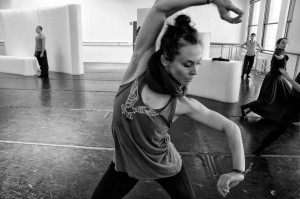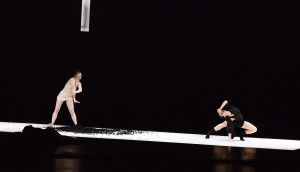The Chicago dance community lost an innovative cultural gem when Luna Negra Dance Theater (LNDT) closed its doors in spring of 2013. An extended hiatus for the dancers hit in March, artistic director Gustavo Ramírez Sansano stepped down in April and the Board of Directors announced it was ceasing operations last May. The dancers and artistic staff, stunned and out of work, dispersed around the world. So, where are they now? What are they up to? RB set out to find out and we’ll here from each of them in the upcoming months.
First up, dancer Kirsten Shelton.
Where are you?
I am still in the Chicagoland area. I own a home in a northwest village where I have lived for nearly three years. I don’t have any plans to relocate at this time. I am quite content with my home and family life.
What are you doing now?
I have been working on my undergraduate degree over the past six years and am finally set to graduate with my BS in Liberal Studies from Oregon State University in December. I haven’t danced since April, and while that was largely due to lack of work and resources, it is also because it is just easier to reflect on…‘big’ questions or painful loss by putting a little distance between that thing and yourself. Sometimes loss can also be seen as an opportunity to reevaluate what you’ve done (or not) up to now and allows a space for finding a new identity, so to speak. It’s easy to understand how rattled one can become after unexpectedly losing a job they had been completely immersed in and completely in love with. But a little break in the norm can also offer a better perspective much of the time, and I know I’m definitely not done dancing yet. In what capacity, I have yet to decide/learn/find. That’s all I know for now, which is fine with me.
What do you miss about LNDT?
This is the only company I have ever had a professional contract with. I joined in 2002 as a fledging 20-year-old under the founder/director, Eduardo Vilaro, and have remained ever since. I have to say that what I miss MOST is being in a position where I am surrounded by exceptional people who are at the top of their game in the trade that we all share. The other individuals answering this same set of questions are some of the best dancers and artists I have known either professionally or personally. But I was with Luna for over a decade and have had the stellar opportunity to watch and know so many dancers who have passed through the company along their own journeys, and I think of all of those people sometimes, even still. Witnessing the process of excellence is lovely, and I am sometimes convinced that dancers have the best mechanism there is to develop the depth of human compassion and connection the rest of the world sometimes lacks. Maybe it’s just the nature of dance, but I don’t know of many other professions where (despite personal differences), I feel love for the people I work with – and I think most dancers know just what I mean. I miss getting to watch people I care about move and grow and learn and amaze me on a daily basis. That applies to all of those dancers and artists I have been so lucky to know throughout the years I was in the company.
What was special about LNDT? What did it mean to be a “Lunatic”?
Similarly, Luna was special to me because it was my professional and artistic home for much of my adult life. I participated in so many different kinds of work under two very different artistic and aesthetic visions and can’t imagine what I would be now without having put all of those experiences in my pocket. I always felt that Luna presented work with a voice that is not seen elsewhere in this city, and as the company grew and evolved, it developed an identity that was unusual and interesting on a broader level. Some of the work – especially a lot of what Gustavo created in recent years – is second to none in my mind, not just here but anywhere that professional contemporary dance exists. I am the kind of dancer that feels that doing work which is relevant is what makes my ‘job’ worthwhile. Even as an audience member, I am more interested in the quality of the work I am witnessing the performance of, because good dancers with incredible skills are everywhere and even great dancers doing irrelevant work does not necessarily make a worthwhile show/company/artform. Luna has always cultivated work that has relevance and though I didn’t love everything in the rep, it was meaningful to me because it fit into the bigger picture which was built around the vision of the choreographer. That is why, from its foundation, Luna was a special place and why I wanted to remain a dancer with that particular company until it ceased to be.
You can see Kirsten perform in Dance Chance Redux 5.0, Friday, October 11 at 8 p.m. at the NEIU Auditorium at Northeastern Illinois University, 5500 N St Louis Ave. Purchase tickets here.


